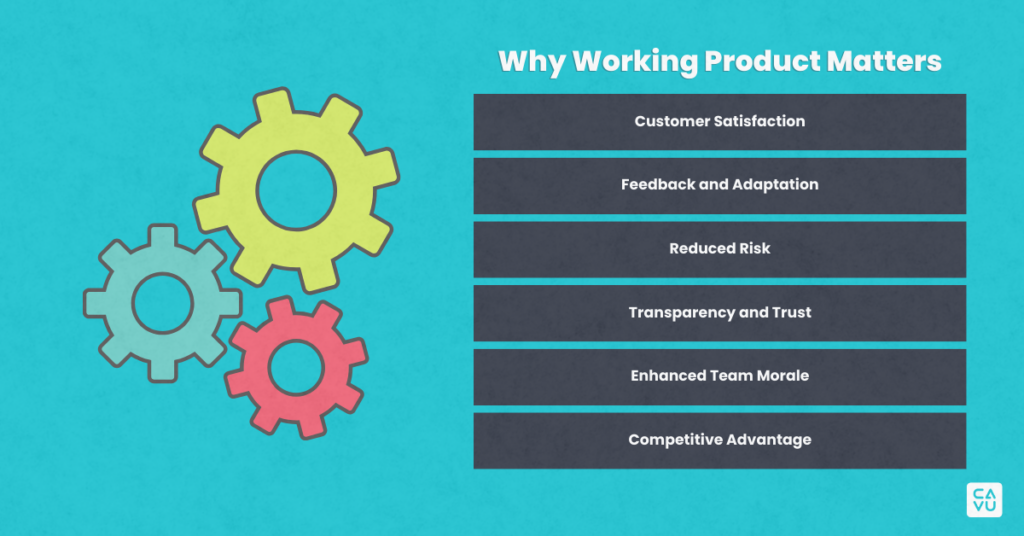As we continue our series on The Twelve Principles Behind the Agile Manifesto, let’s examine “Working Software is the Measure of Progress.” This principle emphasizes the critical importance of delivering functional software or a functional product regularly throughout a project. But why is working software or product so vital, and how does it steer teams towards success?
Understanding the Principle
When we say, “working software,” we’re referring to a product that isn’t just a collection of features, but something that users can interact with, providing real value. In this blog post, we will use the term working product, instead of working software, as Scrum and Agile apply to a wide variety of industries.
The principle of working product as the primary measure of progress shifts the focus from merely ticking off tasks on a project plan to delivering tangible, operational product. It’s a practical measure, providing immediate feedback and value, allowing teams to adapt and iterate based on actual user experience.
Why Working Product Matters

Customer Satisfaction
Delivering working product frequently ensures that customers see progress and value regularly. It aligns with the Agile aim of early and continuous delivery, keeping stakeholders engaged and satisfied. When customers can interact with the product early and often, they feel more connected to the development process. This engagement fosters a stronger relationship between the development team and the customers, resulting in higher satisfaction levels as customers see their needs and feedback being addressed promptly.
Feedback and Adaptation
By focusing on working product, teams receive early feedback, allowing them to adapt to changes more swiftly. This feedback loop is crucial for refining features and ensuring the product evolves to meet user needs. Regular interactions with the product provide real-world data on how users engage with it, revealing both strengths and areas for improvement. This continuous cycle of feedback and adaptation ensures that the final product is well-tuned to the actual requirements and preferences of its users, reducing the risk of building features that do not add value.
Reduced Risk
Regularly delivering working product mitigates risks. It avoids the “big bang” approach where issues are only discovered late in the project lifecycle, which can be costly and time-consuming to fix. By delivering smaller, functional increments, teams can identify and address potential problems early. This incremental approach allows for course corrections before small issues escalate into significant problems, ensuring the project stays on track and within budget. Early and frequent releases also provide opportunities to pivot or make strategic changes based on market feedback or new business insights, further reducing the overall risk.
Transparency and Trust
Building transparency within the team and with stakeholders is another key advantage of delivering working product regularly. Progress becomes visible and measurable, moving beyond abstract reports or updates to actual, tangible results. This transparency builds trust, as stakeholders can see the continuous progress and the delivery of promised features. Demonstrable results, rather than just promises, create a more reliable and trustworthy development process. When stakeholders trust the team, it leads to a more supportive and cooperative environment, which is critical for successful project delivery.
Enhanced Team Morale
Seeing the tangible results of their efforts can significantly boost team morale. Regularly delivering a working product provides a sense of accomplishment and progress, reinforcing the value of the team’s work. This positive reinforcement can increase motivation and drive, leading to a more productive and engaged team. Moreover, the continuous delivery of working product aligns with Agile’s iterative nature, providing regular intervals for celebration and reflection, which can further enhance team spirit and cohesion.
Competitive Advantage
In today’s fast-paced market, being able to deliver a working product regularly can provide a significant competitive advantage. It allows organizations to respond quickly to market changes, user feedback, and emerging opportunities. This agility ensures that the product remains relevant and competitive, adapting swiftly to new requirements or shifts in user expectations. By continuously delivering valuable product increments, organizations can stay ahead of competitors who might still be working on monolithic, less adaptable projects.

Implementing the Principle
- Incremental Development: Break down the product into smaller, manageable increments that can be developed and delivered within short iterations or sprints. This approach ensures continuous progress and constant refinement.
- Definition of Done: Establish a clear “Definition of Done” that includes criteria ensuring that every increment of software is potentially shippable. This includes coding, testing, and integration into the main branch, ensuring no hidden work is left.
- Continuous Improvement: Implement Continuous Improvement practices where processes and workflows are regularly evaluated and enhanced. This practice supports the delivery of working product by identifying inefficiencies and areas for improvement early.
- User Stories and Acceptance Criteria: Use user stories with clear acceptance criteria to define what “done” looks like. This ensures that the team understands what needs to be delivered for the product to be considered working and valuable.
Conclusion
The principle that “Working Software is the Primary Measure of Progress” is a cornerstone of Agile methodology. It ensures that teams remain focused on delivering value, maintaining flexibility, and continuously improving. By prioritizing working product, Agile teams can navigate the complexities of development with clarity and purpose, ultimately delivering products that delight users and meet business goals.








